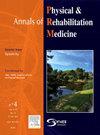Effects of augmented reality-based telerehabilitation in adhesive capsulitis of the shoulder: a randomized controlled trial
IF 4.6
3区 医学
Q1 REHABILITATION
Annals of Physical and Rehabilitation Medicine
Pub Date : 2025-06-01
DOI:10.1016/j.rehab.2025.101956
引用次数: 0
Abstract
Background
Home exercise is important for the treatment of adhesive capsulitis of the shoulder (ACS). Although studies on telerehabilitation to increase compliance and accuracy of home exercise are increasing in various musculoskeletal conditions, there are few studies on ACS.
Objectives
This study aims to investigate the effectiveness of augmented reality (AR)-based asynchronous telerehabilitation using UNICARE Home+ versus conventional home exercise in participants with ACS.
Methods
One hundred participants with unilateral ACS were recruited and randomly assigned to telerehabilitation group (TR group) and conventional rehabilitation group (CR group). All participants, regardless of group, received the same hospital-based physical therapy once or twice for at least 3 months, plus an additional 3 months of home exercise. The TR group performed home exercises with an asynchronous telerehabilitation system, and the CR group performed home exercises with brochures. The primary outcome was the changes in the passive range of motion (PROM) of the affected shoulder joint between baseline and 3 months. The secondary outcomes were active ROM (AROM), shoulder pain measured by Numeric Rating Scale (NRS), shoulder pain and disability index (SPADI), 36-Item Short Form Survey (SF-36), European Quality of Life Five Dimensions Five Level Scale (EQ-5D-5L), and Canadian Occupational Performance Measure (COPM) at the 6 assessment points: at baseline, 1-, 2-, 3-, 4.5- and 6-month.
Results
There were no statistically significant differences in baseline PROM and 3-month PROM between the 2 groups. From baseline to 6 months, all PROM, all AROM, NRS, SPADI, COPM, SF-36 and EQ-5D-5L were significantly improved over time within each group in both groups (all P<0.001). However, there was no significant GroupTime interaction in any outcome, which means that the effect of time did not depend on which group the participants belonged to.
Conclusion
AR and Kinect sensor-based telerehabilitation for participants with ACS improved shoulder pain, functional outcomes, and quality of life, but did not show superiority over conventional rehabilitation.
ClinicalTrials.gov: NCT04316130
基于增强现实的远程康复治疗肩粘连性囊炎的效果:一项随机对照试验
背景:家庭运动对于治疗肩粘连性囊炎(ACS)非常重要。尽管在各种肌肉骨骼疾病中,关于远程康复以提高家庭运动依从性和准确性的研究越来越多,但关于ACS的研究却很少。本研究旨在探讨基于增强现实(AR)的异步远程康复与传统家庭锻炼在ACS患者中的效果。方法将100例单侧ACS患者随机分为远程康复组(TR组)和常规康复组(CR组)。所有参与者,无论分组,都接受了一次或两次相同的医院物理治疗,持续至少3个月,再加上另外3个月的家庭锻炼。TR组使用异步远程康复系统进行家庭练习,CR组使用小册子进行家庭练习。主要结果是受影响肩关节的被动活动范围(PROM)在基线和3个月之间的变化。次要结果是活动性关节活动度(AROM)、肩痛数值评定量表(NRS)、肩痛和残疾指数(SPADI)、36项简短问卷调查(SF-36)、欧洲生活质量五维度五水平量表(EQ-5D-5L)和加拿大职业绩效量表(COPM)在基线、1个月、2个月、3个月、4.5个月和6个月的6个评估点。结果两组患者基线胎膜早破和3个月胎膜早破差异无统计学意义。从基线到6个月,两组每组的所有PROM、所有AROM、NRS、SPADI、COPM、SF-36和EQ-5D-5L均随时间显著改善(p < 0.001)。然而,在任何结果中都没有显著的Group×Time交互作用,这意味着时间的影响并不取决于参与者属于哪一组。结论:基于ar和Kinect传感器的远程康复治疗可改善ACS患者的肩痛、功能结局和生活质量,但没有显示出传统康复的优势
本文章由计算机程序翻译,如有差异,请以英文原文为准。
求助全文
约1分钟内获得全文
求助全文
来源期刊

Annals of Physical and Rehabilitation Medicine
Medicine-Rehabilitation
CiteScore
7.80
自引率
4.30%
发文量
136
审稿时长
34 days
期刊介绍:
Annals of Physical and Rehabilitation Medicine covers all areas of Rehabilitation and Physical Medicine; such as: methods of evaluation of motor, sensory, cognitive and visceral impairments; acute and chronic musculoskeletal disorders and pain; disabilities in adult and children ; processes of rehabilitation in orthopaedic, rhumatological, neurological, cardiovascular, pulmonary and urological diseases.
 求助内容:
求助内容: 应助结果提醒方式:
应助结果提醒方式:


